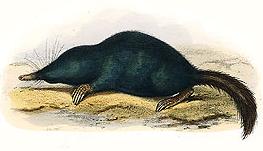Japanese pointed mulle
| Japanese pointed mulle | ||||||||||||
|---|---|---|---|---|---|---|---|---|---|---|---|---|

Urotrichus talpoides |
||||||||||||
| Systematics | ||||||||||||
|
||||||||||||
| Scientific name | ||||||||||||
| Urotrichini | ||||||||||||
| Dobson , 1883 |
The Japanese shrew mole (Urotrichini; Japanese ヒ ミ ズ 族 , Himizu-zoku ) are a generic group of the mole family (Talpidae) with two species that are endemic to Japan .
description
The body of the Japanese shrew mole is similar to that of the shrew . The feet are narrow and have only small grave claws, the limbs are relatively long. The face has an elongated snout, the eyes are very small, the ears are hidden in the fur. The fur is dense, but less velvety than that of other mole species, its coloration varies from dark brown to black. With a head body length of 6 to 10 centimeters and a weight of 14 to 20 grams, they are among the smallest moles. The 2 to 4 centimeters long tail is relatively thick.
distribution and habitat
Both species inhabit the southern three main Japanese islands ( Honshū , Shikoku , Kyūshū ) and some offshore islands. Their habitat are forests and grasslands.
Way of life
Japanese pointed mole are found on the surface more often than other mole species, they are also good at climbing and swimming. They create paths in the rotting plant material on the ground, and sometimes they also dig passages below the surface. The diet of these animals consists mainly of earthworms, insects and spiders. Little is known about their reproduction; the female probably gives birth to two to four young animals several times a year after a gestation period of around four weeks.
Systematics and types
Contrary to earlier views, the Japanese pointed mole rat are not closely related to the American pointed mole rat , but have only developed convergent to it.
A distinction is made between two types, each of which has its own genus. (In some works both species are still found in the genus Urotrichus .)
- Dymecodon pilirostris (Japanese ヒ メ ヒ ミ ズ , Himehimizu ) lives primarily in coniferous forests in mountainous regions.
- Urotrichus talpoides (Japaneseヒ ミ ズ , Himizu ) is native to grasslands and forests.
According to the IUCN, both species are not threatened.
literature
- Ronald M. Nowak: Walker's Mammals of the World. 2 volumes. 6th edition. The Johns Hopkins University Press, Baltimore MD et al. 1999, ISBN 0-8018-5789-9 .
- Don E. Wilson , DeeAnn M. Reeder (Eds.): Mammal Species of the World . A taxonomic and geographic Reference. 2 volumes. 3. Edition. The Johns Hopkins University Press, Baltimore MD 2005, ISBN 0-8018-8221-4 .
Web links
- Endangerment level of the two species in the IUCN Red List of Threatened Species .